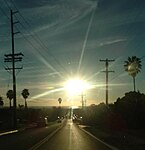O'Farrell Community School or The O'Farrell Charter School (CDE official name), commonly referred to as O'Farrell, is a charter school in the Southeast San Diego neighborhood of Encanto serving grades K-12 in the K-12 American education system. The school opened its doors in the San Diego Unified School District in 1959 with its name chosen in 1957 as Mabel E. O'Farrell Jr. High. It was voted to become a charter school in 1994. President Bill Clinton made a visit to San Diego in 1995 to sign the "Goals 2000" education bill and to visit O'Farrell because it was charter. It was also mentioned in Hillary Clinton's book It Takes a Village. It has a code of conduct of how to become a good citizen called The Falcon Way, of Focus, Attitude, Leadership Citizenship, Organization, and Non-Violience, that is indoctrinated per student. Instead of being called principal, faculty and students refer to the educational leader as the Chief Educational Officer (CEO). The large conspicuous mural in front of the school on the side of the Theatre was a tribute to a faculty member by the nickname "Animal" who died. The mural was painted by students.
For 2006-2007, the school academic progress place it with an Academic Performance Index of 710 base with 720 growth, where 800 is the California state goal. The school boasted itself as being #1 in API compared to other surrounding schools in its November 2007 edition of its newsletter. For October 2005, the demographic makeup of the student body consisted of 36% Hispanic, 31% Black, 24% Filipino, 3%White.Hillary Clinton also mentions the O'Farrell way extending beyond these rules that also includes the graduation requirement of time for community service. However, the graduation requirement actually fits under The O'Farrell Standard which is just an award and recognition issued for those who have essentially accomplished (1) good academic performance, (2) portfolio compilation, (3) presentation of the portfolio, (4) 12 hours of community service equally distributed at home, work, school; (5) good citizenship The O'Farrell Way all of which were mentioned in the school's charter proposal.









